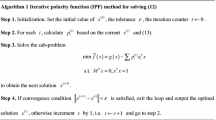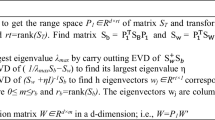Abstract
Feature extraction by Maximum Margin Criterion (MMC) can more efficiently calculate the discriminant vectors than LDA, by avoiding calculation of the inverse within-class scatter matrix. But MMC ignores the local structures of samples. In this paper, we develop a novel criterion to address this issue, namely Laplacian Maximum Margin Criterion (Laplacian MMC). We define the total Laplacian matrix, within-class Laplacian matrix and between-class Laplacian matrix by using the similar weight of samples to capture the scatter information. Laplacian MMC based feature extraction gets the discriminant vectors by maximizing the difference between between-class laplacian matrix and within-class laplacian matrix. Experiments on FERET and AR face databases show that Laplacian MMC works well.
Similar content being viewed by others
Explore related subjects
Discover the latest articles, news and stories from top researchers in related subjects.References
Jain AK, Chandrasekaran B (1982) Dimension and sample size consideration in pattern recognition practice. In Handbook of statistic. North-Holland, Amsterdam
Duda RO, Hart PE (1973) Pattern classification and scene analysis. Wiley, New York
Yang M, Zhang L (2010) Gabor feature based sparse representation for face recognition with Gabor occlusion dictionary. In: ECCV, Heraklion
Yang M, Zhang L, Zhang D, Yang J (2010) Metaface learning for sparse representation based face recognition. In: ICIP
Zhang L, Yang M, Feng Z, Zhang D (2010) On the dimensionality reduction for sparse representation based face recognition. In: ICPR
Raudys SJ, Jain AK (1991) Small sample size effects in statistical pattern recognition: recommendations for practitioners. IEEE Trans Pattern Anal Mach Intell 13(3): 252–264
Swets DL, Weng J (1996) Using discriminant eigenfeatures for image retrieval. IEEE Trans Pattern Anal Mach Intell 18(8): 831–836
Belhumeur V, Hespanha J, Kriegman D (1997) Eigenfaces vs. Fisherfaces: recognition using class specific linear projection. IEEE Trans Pattern Anal Mach Intell 19(7): 711–720
Yang J, Yang JY (2003) Why can LDA be performed in PCA transformed space?. Pattern Recognit 36(2): 563–566
Hong ZQ, Yang JY (1991) Optimal discriminant plane for a small number of samples and design method of classifier on the plane. Pattern Recognit 24(4): 317–324
Friedman JH (1989) Regularized discriminant analysis. J Am Stat Assoc 84: 165–175
Hastie T, Tibshirani R (1995) Penalized discriminant analysis. Ann Stat 23: 73–102
Hastie T, Tibshirani R, Buja A (1994) Flexible discriminant analysis by optimal scoring. J Am Stat Assoc 89: 1255–1270
Chen LF, Liao HYM, Ko MT, Yu GJ (2000) A new LDA-based face recognition system which can solve the small sample size problem. Pattern Recognit 33(1): 1713–1726
Yu H, Yang J (2001) A direct LDA algorithm for high dimensional data—with application to face recognition. Pattern Recognit 34(10): 2067–2070
Gao QX, Zhang L, Zhang D (2008) Face recognition using FLDA with single training image per-person. Appl Math Comput 205(12): 726–734
Zhuang XS, Dai DQ (2007) Improved discriminant analysis for high-dimensional data and its application to face recognition. Pattern Recognit 40(5): 1570–1578
Jin Z, Yang JY, Hu Z, Lou Z (2001) Face recognition based on the uncorrelated discrimination transformation. Patter Recognit 34(7): 1405–1416
Li H, Jiang T, Zhang K (2006) Efficient and robust feature extraction by maximum margin criterion. IEEE Trans Neural Netw 17(1): 1157–1165
Zhang B, Chen X, Shan S, Gao W (2005) Nonlinear face recognition based on maximum average margin. In: CVPR, vol 1, pp 554–559
Zheng W, Zou C, Zhao L (2005) Weighted maximum margin discriminant analysis with kernels. Neurocomputing 67: 357–363
Yan J, Zhang B, Yan S et al (2004) IMMC: incremental maximum margin criterion. In: Proceedings of the 10th ACM SIGKDD international conference on knowledge discovery and data mining
Tenenbaum JB, de Silva V, Langford JC (2000) A global geometric framework for nonlinear dimensionality reduction. Science 290: 2319–2323
Roweis ST, Saul LK (2000) Nonlinear dimension reduction by locally linear embdedding. Science 290: 2323–2326
Belkin M, Niyogi P (2003) Laplacian eigenmaps for dimensionality reduction and data representation. Neural Comput 15(6): 1373–1396
He X, Yan S, Hu Y, Niyogi P, Zhang H (2005) Face recognition using Laplacianfaces. IEEE Trans Pattern Anal Mach Intell 27(3): 328–340
Yang J, Zhang D, Yang JY, Niu B (2007) Globally maximizing, locally minimizing: unsupervised discriminant projection with applications to face and palm biometrics. IEEE Trans Pattern Anal Mach Intell 29(4): 650–664
Yan S, Xu D, Zhang B, Zhang H-J (2007) Graph embedding and extensions: a general framework for dimensionality reduction. IEEE Trans Pattern Anal Mach Intell 29(1): 40–51
Chen HT, Chang HW, Liu TL (2005) Local discriminant embedding and its variants. In: Proceedings of the IEEE conference on computer vision and pattern recognition (CVPR), vol 2, pp 846–853
Wang F, Zhang CS (2007) Feature extraction by maximizing the average neighborhood margin. In: Proceedings of the IEEE conference on computer vision and pattern recognition, pp 1–8
Zhao DL, Liu ZC, Xiao R, Tang XO (2007) Linear laplacian discrimination for feature extraction. In: Proceedings of the IEEE conference on computer vision and pattern recognition, pp 1–7
Yu WW, Teng XL, Liu CQ (2006) Face recognitin using discriminant locality preserving projection. Image Vis Comput 24: 239–248
Yang WK, Wang JG, Ren M, Yang JY (2008) Feature extraction based on local maximum margin criterion. In: Proceedings of the IEEE conference on computer vision and pattern recognition, pp 1–4
Xian-da Z (2004) Matrix analysis and application (in Chinese). Tsinghua University Press, Beijing
Phillips PJ, Moon H, Rizvi SA, Rauss PJ (2000) The FERET evaluation methodology for face-recognition algorithms. IEEE Trans Pattern Anal Mach Intell 22(10): 1090–1104
Phillips PJ (2004) The facial recognition technology (FERET) database. http://www.itl.nist.gov/iad/humanid/feret/feret_master.html
Martinez AM, Benavente R The AR face database. http://cobweb.ecn.purdue.edu/~aleix/aleix_face_DB.html
Martinez AM, Benavente R (1998) The AR face database. CVC technical report #24, June
Author information
Authors and Affiliations
Corresponding author
Rights and permissions
About this article
Cite this article
Yang, W., Sun, C., Du, H.S. et al. Feature Extraction Using Laplacian Maximum Margin Criterion. Neural Process Lett 33, 99–110 (2011). https://doi.org/10.1007/s11063-010-9167-4
Published:
Issue Date:
DOI: https://doi.org/10.1007/s11063-010-9167-4




